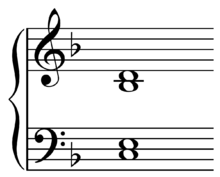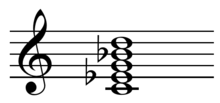- Ninth chord
-
A ninth chord is a chord that encompasses the interval of a ninth when arranged in close position with the root in the bass.[2]
A dominant ninth is a dominant chord with a ninth. A ninth chord, as an extended chord, typically includes the seventh along with the basic triad structure. Thus, a Cmaj9 consists of C E G B and D
 play (help·info). When the symbol "9" is not preceded by the word "major" or "maj", the implied seventh is a dominant seventh—e.g. a C9 consists of C E G B♭ and D
play (help·info). When the symbol "9" is not preceded by the word "major" or "maj", the implied seventh is a dominant seventh—e.g. a C9 consists of C E G B♭ and D  play (help·info), and would usually be expected to resolve into a chord of F major (the implied key, C being the dominant of F). The ninth is commonly chromatically altered by half-step either up or down to create more tension and dissonance.
play (help·info), and would usually be expected to resolve into a chord of F major (the implied key, C being the dominant of F). The ninth is commonly chromatically altered by half-step either up or down to create more tension and dissonance.In the common practice period, "the root, 3rd, 7th, and 9th are the most common factors present in the V9 chord," with the 5th, "typically omitted".[3] The 9th and 7th usually resolve downward to the 5th and 3rd of I.[3]
The minor ninth chord is played with the third and seventh both flattened. The formula is 1, ♭3, 5, ♭7, 9. This chord is written as Cm9. This chord has a more "bluesy" sound and fits very well with the dominant 9th.
An added ninth chord is a major triad with an added ninth. Thus, Cadd9 consists of C E G and D. (The D, which might be called an added second, is two fifths up from the root.) Added ninth chords differ from other ninth chords because the seventh is not included.
The 6/9 chord is a pentad in which a major triad is extended with a sixth and 9th above the root, but no seventh, thus: C6/9 is C,E,G,A,D. It is not a tense chord requiring resolution, and is considered a substitute for the tonic in jazz. Its constituent notes are those of the pentatonic scale.[6]
Heinrich Schenker, though he allowed the substitution of the dominant seventh, leading-tone, and leading tone half-diminished seventh chords, rejected the concept of a ninth chord on the basis that only that on the fifth scale degree (V9) was admitted and that inversion was not allowed of the ninth chord.[7]
Second
See also: Added tone chord Third inversion C added ninth chord. The "ninth" is the bass. D11 chord.
Third inversion C added ninth chord. The "ninth" is the bass. D11 chord.
In music, the second factor of a chord is the note or pitch two scale degrees above the root or tonal center. When the second is the bass note, or lowest note, of the expressed chord, the chord is in third inversion
 Play (help·info). However, this is equivalent to a gapped eleventh chord.
Play (help·info). However, this is equivalent to a gapped eleventh chord.Conventionally, the second is third in importance to the root, fifth, and third, being an added tone. It is generally not allowed as the root since that inversion resembles an eleventh chord on the second rather than an added tone chord on the original note. In jazz chords and theory, the second is required due to its being an added tone.
The quality of the second may be determined by the scale or may be indicated. For example, in both a major and minor scale a diatonic second added to the tonic chord will be major (C-D-E-G or C-D-E♭-G) while one added to the dominant chord will be major or minor (G-A-B-D or G-A♭-B♭-D), respectively.
 Suspended chord (sus2) and added tone chord (add9) both with D (ninth=second), distinguished by the absence or presence of the third (E♭).[9]
Suspended chord (sus2) and added tone chord (add9) both with D (ninth=second), distinguished by the absence or presence of the third (E♭).[9]
The second is octave equivalent to the ninth. If one could cut out the note in between the fifth and the ninth and then drop the ninth down an octave to a second, one would have a second chord (CEGB♭D' – B♭ = CDEG). The difference between sus2 and add9 is conventionally the absence or presence, respectively, of the third.
See also
Sources
- ^ Stephenson, Ken (2002). What to Listen for in Rock: A Stylistic Analysis, p.85. ISBN 9780300092394.
- ^ Sadie, Stanley, ed. (1980). "Ninth chord", p.252, The New Grove Dictionary of Music and Musicians, vol. 13. ISBN 1-56159-174-2.
- ^ a b c Benward & Saker (2009). Music in Theory and Practice: Volume II, p.183-84. Eighth Edition. ISBN 978-0-07-310188-0.
- ^ Benward & Saker (2009), p.179.
- ^ Walter Everett (Autumn, 2004). "A Royal Scam: The Abstruse and Ironic Bop-Rock Harmony of Steely Dan", p.208-209, Music Theory Spectrum, Vol. 26, No. 2, pp. 201-235.
- ^ Jazz Lessons
- ^ Schenker, Heinrich (1980). Harmony, p.190. ISBN 9780226737348.
- ^ Kostka & Payne (1995). Tonal Harmony, p.431. Third Edition. ISBN 0-07-300056-6.
- ^ Hawkins, Stan. "Prince- Harmonic Analysis of 'Anna Stesia'", p.329 and 334n7, Popular Music, Vol. 11, No. 3 (Oct., 1992), pp. 325-335.
Chords By type Major · Minor · Dominant · Dominant seventh flat five · Diminished · Half-diminished · Diminished major · Minor-major · Augmented major · Augmented minor · Nondominant · Harmonic seventh chordAdded
/ omittedBy function SecondaryWith names Elektra chord · Farben chord · Hendrix chord · Mu chord · Mystic chord · Northern lights chord · Petrushka chord · Power chord · Psalms chord · So What chord · Spider chord · Tristan chord · Viennese trichord · Dream chordOther Common chord (music) · Mixed interval · Open chord · Polychord · Primary triad · Quartal and quintal · Slash chord · Subsidiary chord · Synthetic chord · Tone clusterCategories:- Chords
- Chord factors
Wikimedia Foundation. 2010.







